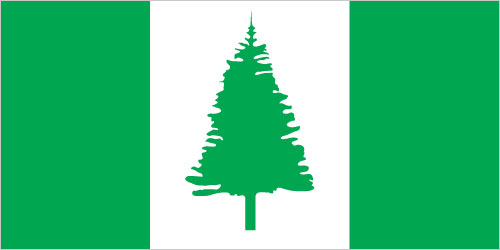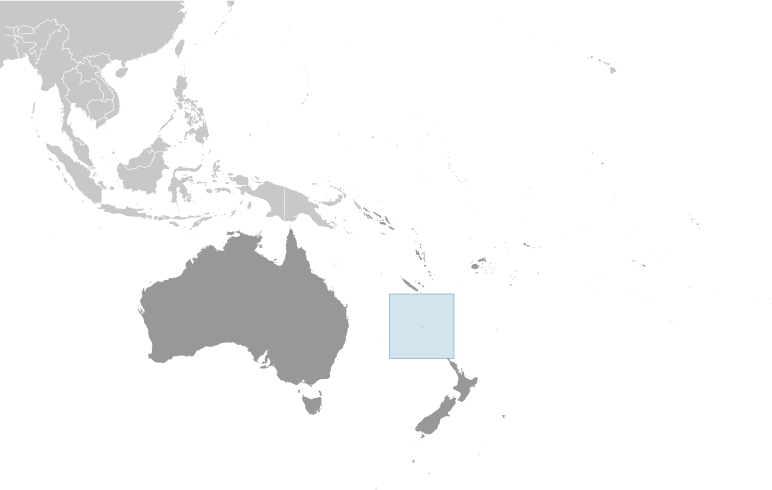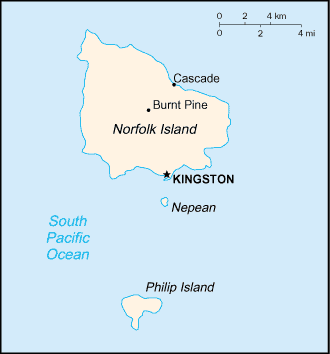


-
Introduction :: Norfolk Island
-
Background:Two British attempts at establishing the island as a penal colony (1788-1814 and 1825-55) were ultimately abandoned. In 1856, the island was resettled by Pitcairn Islanders, descendants of the Bounty mutineers and their Tahitian companions.
-
Geography :: Norfolk Island
-
Location:Oceania, island in the South Pacific Ocean, east of AustraliaGeographic coordinates:29 02 S, 167 57 EMap references:OceaniaArea:total: 36 sq kmland: 36 sq kmwater: 0 sq kmcountry comparison to the world: 235Area - comparative:about 0.2 times the size of Washington, DCLand boundaries:0 kmCoastline:32 kmMaritime claims:territorial sea: 12 nmexclusive fishing zone: 200 nmClimate:subtropical; mild, little seasonal temperature variationTerrain:volcanic island with mostly rolling plainsElevation:lowest point: Pacific Ocean 0 mhighest point: Mount Bates 319 mNatural resources:fishLand use:agricultural land: 25% (2011 est.)arable land: 0% (2011 est.) / permanent crops: 0% (2011 est.) / permanent pasture: 25% (2011 est.)forest: 11.5% (2011 est.)other: 63.5% (2011 est.)Irrigated land:0 sq km (2012)Population distribution:population concentrated around the capital of KingstonNatural hazards:tropical cyclones (especially May to July)Environment - current issues:inadequate solid waste management; most freshwater obtained through rainwater catchment; preservation of unique ecosystemGeography - note:most of the 32 km coastline consists of almost inaccessible cliffs, but the land slopes down to the sea in one small southern area on Sydney Bay, where the capital of Kingston is situated
-
People and Society :: Norfolk Island
-
Population:1,748 (2016 est.)country comparison to the world: 232Nationality:noun: Norfolk Islander(s)adjective: Norfolk Islander(s)Ethnic groups:
Australian 22.8%, English 22.4%, Pitcairn 20%, Scottish 6%, Irish 5.2%
(2011 est.)note: respondents were able to identify up to two ancestries; percentages represent a proportion of all responses from people in Norfolk Island, including those who did not identify an ancestry; only top responses are shownLanguages:English (official) 44.9%, Norfolk (also known as Norfuk or Norf'k, which is a mixture of 18th century English and ancient Tahitian) 40.3%, Fijian 1.8%, other 6.8%, unspecified 6.2% (2016 est.)note: data represent language spoken at home
Religions:Protestant 46.8% (Anglican 33.6%, Uniting Church in Australia 12.8%, Seventh Day Adventist 3.2%), Roman Catholic 12.6%, other Christian 2.9%, other 1.4%, none 26.7%, unspecified 9.5% (2016 est.)Population growth rate:0.01% (2014 est.)country comparison to the world: 191Population distribution:population concentrated around the capital of KingstonSex ratio:NAInfant mortality rate:total: NA (2018)male: NAfemale: NALife expectancy at birth:total population: NA (2017 est.)male: NAfemale: NATotal fertility rate:NAHIV/AIDS - adult prevalence rate:NAHIV/AIDS - people living with HIV/AIDS:NAHIV/AIDS - deaths:NAEducation expenditures:NA -
Government :: Norfolk Island
-
Country name:conventional long form: Territory of Norfolk Islandconventional short form: Norfolk Islandetymology: named by British explorer Captain James COOK after Mary HOWARD, Duchess of Norfolk, in 1774Dependency status:self-governing territory of Australia; administered from Canberra by the Department of Regional Australia, Local Government, Arts, and SportGovernment type:non-self-governing overseas territory of Australia; note - the Norfolk Island Regional Council, which began operations 1 July 2016, is responsible for planning and managing a variety of public services, including those funded by the Government of AustraliaCapital:name: Kingstongeographic coordinates: 29 03 S, 167 58 Etime difference: UTC+11 (16 hours ahead of Washington, DC, during Standard Time)etymology: the name is a blending of the words "king's" and "town"; the British king at the time of the town's settlement in the late 18th century was George IIIAdministrative divisions:none (territory of Australia)Independence:none (territory of Australia)National holiday:Bounty Day (commemorates the arrival of Pitcairn Islanders), 8 June (1856)Constitution:history: previous 1913, 1957; latest effective 7 August 1979amendments: amended many times, last in 2015 (2017)Legal system:English common law and the laws of AustraliaCitizenship:see AustraliaSuffrage:18 years of age; universalExecutive branch:chief of state: Queen ELIZABETH II (since 6 February 1952); represented by Governor General of the Commonwealth of Australia General Sir Peter COSGROVE (since 28 March 2014)head of government: Administrator Eric HUTCHINSON (since 1 April 2017)cabinet: Executive Council consists of 4 Legislative Assembly memberselections/appointments: the monarchy is hereditary; governor general appointed by the monarch; administrator appointed by the governor general of Australia for a 2-year term and represents the monarch and AustraliaLegislative branch:description: unicameral Norfolk Island Regional Council (5 seats; councillors directly elected by simple majority vote to serve 4-year terms); mayor elected annually by the councillorselections: elections last held 28 May 2016 (next to be held in 2020)election results: seats by party - independent 5; composition - men 4, women 1, percent of women 20%
note: following an administrative restructuring of local government, the Legislative Assembly was dissolved on 18 June 2015 and replaced by an interim Norfolk Island Advisory Council effective 1 July 2015; the Advisory Council consisted of 5 members appointed by the Norfolk Island administrator based on nominations from the community; following elections on 28 May 2016, the new Norfolk Island Regional Council commenced operations on 1 July 2016
Judicial branch:highest courts: Supreme Court of Norfolk Island (consists of the chief justice and several justices); note - appeals beyond the Supreme Court of Norfolk Island are heard by the Federal Court and the High Court of Australiajudge selection and term of office: justices appointed by the governor general of Australia from among justices of the Federal Court of Australia; justices serve until mandatory retirement at age 70subordinate courts: Petty Court of Sessions; specialized courts, including a Coroner's Court and the Employment TribunalPolitical parties and leaders:Norfolk Island Labor Party [Mike KELLY]
Norfolk Liberals [John BROWN]International organization participation:UPUDiplomatic representation in the US:none (territory of Australia)Diplomatic representation from the US:none (territory of Australia)Flag description:three vertical bands of green (hoist side), white, and green with a large green Norfolk Island pine tree centered in the slightly wider white band; green stands for the rich vegetation on the island, and the pine tree - endemic to the island - is a symbol of Norfolk Islandnote: somewhat reminiscent of the flag of Canada with its use of only two colors and depiction of a prominent local floral symbol in the central white band; also resembles the green and white triband of Nigeria
National symbol(s):Norfolk Island pineNational anthem:name: Come Ye Blessedlyrics/music: New Testament/John Prindle SCOTTnote: the local anthem, whose lyrics consist of the words from Matthew 25:34-36, 40, is also known as "The Pitcairn Anthem;" the island does not recognize "Advance Australia Fair" (which other Australian territories use); instead "God Save the Queen" is official (see United Kingdom)
-
Economy :: Norfolk Island
-
Economy - overview:Norfolk Island is suffering from a severe economic downturn. Tourism, the primary economic activity, is the main driver of economic growth. The agricultural sector has become self-sufficient in the production of beef, poultry, and eggs.GDP (purchasing power parity):
NA
Agriculture - products:Norfolk Island pine seed, Kentia palm seed, cereals, vegetables, fruit; cattle, poultryIndustries:tourism, light industry, ready mixed concreteLabor force:978 (2006)country comparison to the world: 229Labor force - by occupation:agriculture: 6%industry: 14%services: 80% (2006 est.)Budget:revenues: 4.6 million (FY99/00)expenditures: 4.8 million (FY99/00)Fiscal year:1 July - 30 JuneExports:NA
Exports - commodities:postage stamps, seeds of the Norfolk Island pine and Kentia palm, small quantities of avocadosImports:$NA
Imports - commodities:NADebt - external:NA
Exchange rates:Australian dollars (AUD) per US dollar -1.311 (2017 est.)1.3291 (2016 est.)1.3291 (2015)1.3291 (2014 est.)1.1094 (2013 est.) -
Communications :: Norfolk Island
-
Telephone system:general assessment: adequatedomestic: free local callsinternational: country code - 672; submarine cable links with Australia and New Zealand; satellite earth station - 1Broadcast media:1 local radio station; broadcasts of several Australian radio and TV stations available via satellite (2009)Internet country code:.nfInternet users:total: 765percent of population: 34.6% (July 2016 est.)country comparison to the world: 225
-
Military and Security :: Norfolk Island
-
Military - note:defense is the responsibility of Australia
-
Transportation :: Norfolk Island
-
Airports:1 (2013)country comparison to the world: 232Airports - with paved runways:total: 1 (2017)1,524 to 2,437 m: 1 (2017)Roadways:total: 80 km (2008)paved: 53 km (2008)unpaved: 27 km (2008)country comparison to the world: 209Ports and terminals:major seaport(s): Kingston
-
Transnational Issues :: Norfolk Island
-
Disputes - international:
none